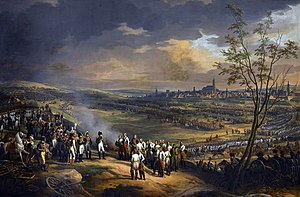
Back حملة أولم Arabic Улмска кампания Bulgarian Ulm-felttoget Danish Ulma Kampanjo Esperanto Campagne d'Ulm French מערכת אולם HE Kampanye militer Ulm ID Campagna di Ulma Italian ウルム戦役 Japanese ულმის კამპანია Georgian
| Ulm campaign | |||||||
|---|---|---|---|---|---|---|---|
| Part of the War of the Third Coalition | |||||||
 The Capitulation of Ulm, a romanticised painting by Charles Thévenin | |||||||
| |||||||
| Belligerents | |||||||
|
|
| ||||||
| Commanders and leaders | |||||||
|
|
| ||||||
| Strength | |||||||
| 165,200[1]–235,000[2] | 72,000[3] | ||||||
| Casualties and losses | |||||||
| 6,000[1] |
10,000 killed or wounded[1] 60,000 captured[1][3][4] | ||||||
The Ulm campaign was a series of French and Bavarian military maneuvers and battles to outflank and capture an Austrian army in 1805 during the War of the Third Coalition. It took place in the vicinity of and inside the Swabian city of Ulm. The French Grande Armée, led by Napoleon, had 210,000 troops organized into seven corps and hoped to knock out the Austrian army in the Danube before Russian reinforcements could arrive.[5] Rapid marching let Napoleon conduct a large wheeling maneuver, which captured an Austrian army of 23,000 under General Mack on 20 October at Ulm. That brought the total number of Austrian prisoners-of-war in the campaign to 60,000. The campaign is by some military historians regarded as a strategic masterpiece and was influential in the development of the Schlieffen Plan in the late 19th century.[6][7] Napoleon himself wrote:[8]
- four months of marching about, months of fatigue and wretchedness, have proved to me that nothing is more hideous, more miserable, than war. And yet our sufferings in the Guard are not to be compared with those of the line.
The victory at Ulm did not end the war since a large Russian army under Kutuzov was near Vienna to defend the city against the French. The Russians withdrew to the northeast to await reinforcements and to link up with Austrian army units. The French moved aggressively forward and captured Vienna on 12 November.[9] On 2 December, a massive battle at Austerlitz, causing around 24,000 - 36,000 casualties, removed Austria from the war. The resulting Peace treaty of Pressburg in late December brought the Third Coalition to an end and established Napoleonic France as the major power in Central Europe, which led to the War of the Fourth Coalition against Prussia and Russia the following year.[10][11]
- ^ a b c d Clodfelter 2017, p. 152.
- ^ Chandler 2009, p. 384, 34. Plans and Preparations (PART SEVEN. From the Rhine to the Danube).
- ^ a b Fisher & Fremont-Barnes 2004, p. 41.
- ^ Nafziger 2002, p. 282, Ulm, Capitulation of. (-U-).
- ^ Schneid 2012, p. 35-50, 3. The Campaigns.
- ^ Brooks 2000, p. 156"It is a historical cliché to compare the Schlieffen Plan with Hannibal's tactical envelopment at Cannae (216 BC); Schlieffen owed more to Napoleon's strategic maneuver on Ulm (1805)"
- ^ Cite error: The named reference
gergeswas invoked but never defined (see the help page). - ^ Jean-Baptiste Barrès, A Memoir of a French Napoleonic Officer (London, 1988), 55. cited in Napoleon and the Operational Art of War, Chapter 5, 1805: Ulm and Austerlitz by Mark T. Gerges
- ^ Forster Groom & Co. Ltd. 1912.
- ^ Cite error: The named reference
allsbrookwas invoked but never defined (see the help page). - ^ Cite error: The named reference
futurewas invoked but never defined (see the help page).
© MMXXIII Rich X Search. We shall prevail. All rights reserved. Rich X Search
